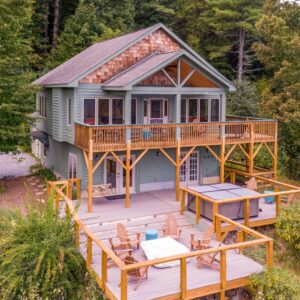Using biowood in the Philippines is becoming a more practical choice due to the growing demand for homes and buildings brought on by the nations’ rapid growth. At the same time, the country is coping with problems like climate change and forest loss. Because of this, a lot of architects and builders are searching for eco-friendly materials. An eco-friendly substitute is provided by biowood, a novel building material composed of recycled plastic and wood fibers. This article will discuss what Biowood is and how it can help the construction industry in the country.
What is Biowood?
Biowood is produced from recycled plastic and wood fibers, with around 40% plastic and 60% wood fibers being used. This combination produces a product that is more resilient to extreme weather conditions and lasts longer while still having the look and feel of real wood. Biowood lessens environmental harm and promotes forest preservation, in contrast to conventional wood, which necessitates the removal of new trees.
Compared to natural wood, biowood is more resilient to rot and pest damage. It also doesn’t warp or break when exposed to the hot, humid climate of the nation. When compared to materials like steel or concrete, the material uses less energy and emits fewer carbon emissions during production. For builders who wish to lessen their environmental effect, this makes it a more environmentally friendly option.
Why is It Good for the Environment?
Saves Resources and Reduces Waste
The fact that Biowood is made from recycled materials is one of its main advantages. The material is produced using plastics and wood fibers that would otherwise be discarded, decreasing the quantity of waste that ends up in landfills. Through this, it can prevent up to 80% of environmental pollution caused by wood and plastic waste.
It also lessens the need for tree-cutting. In certain regions of Luzon, biowood replaces around 30% of the wood used in construction. Preservation of these forests is important, as it is vital in maintaining the land’s wildlife and combatting the effects of climate change.
Supports Green Building Practices
Green building certifications such as LEED (Leadership in Energy and Environmental Design) are compatible with biowood. Because Biowood is made of recycled materials, buildings that use it can receive points. Additionally, it assists builders in adhering to the Philippine Green Building Code, which promotes environmentally friendly and energy-efficient building practices.
The material can contribute to more energy-efficient buildings. When used as sunshading or cladding, it can save 20 to 30% on cooling costs. This is crucial in the Philippines, where the hot weather necessitates frequent use of air conditioning.
How Does It Perform in Philippine Climate?
Strong and Long-Lasting
The Philippines faces tough weather like strong typhoons and high humidity. Biowood performs very well under these conditions. It can resist damage from more powerful typhoons and does not break down easily when exposed to sunlight for long periods.
The material also costs less to maintain than natural wood. Over 10 years, buildings need about half the maintenance, because the material does not need to be painted or treated as often. This is vital for building projects that need to last.
Helps Keep Buildings Cool and Look Great
By permitting air to pass through sun-shading or ventilated facades, biowood helps keep buildings cooler. Indoor temperatures can drop by 3 to 5 degrees Celsius as a result. Because of this natural cooling, less air conditioning is required, saving money and energy.
Additionally, the material is available in a variety of textures and finishes. There are more than fifteen options, including styles that mimic common woods like walnut and teak. This offers designers and architects a wide range of options to complement various styles, from traditional to modern.
What Does It Mean for the Economy and Industry?
Saves Money and Grows in Popularity
While Biowood may cost about the same as some hardwoods at first, it saves money over time. Because it lasts longer and needs less care, its total cost over many years is about 25% lower.
The market is growing fast, with sales increasing by about 40% each year from 2022 to 2025. Both home builders and commercial developers want materials that are affordable and eco-friendly.
Changes In the Construction Industry
Biowood is helping the construction industry become more sustainable and efficient. It supports local recycling businesses and creates jobs in collecting and processing materials. This helps the economy and promotes a circular economy, where waste is reused instead of thrown away.
Key Takeaway
Biowood in the Philippines presents a novel approach to construction that benefits both people and the environment. Buildings last longer and consume less energy thanks to it, and it also lessens waste and the need to cut down trees. The material is becoming a crucial component that can assist the nation in achieving its environmental objectives as it strives to construct more sustainably. Biowood is expected to have a significant impact on the country’s building industry in the future due to its numerous advantages and rising popularity.




